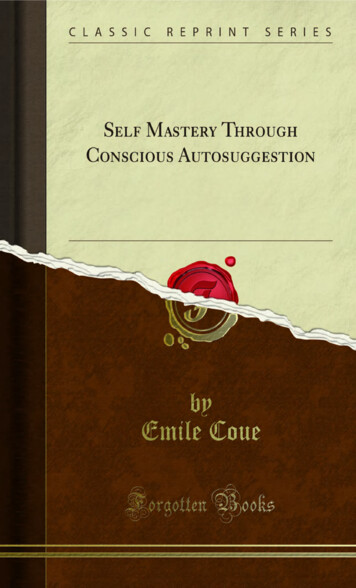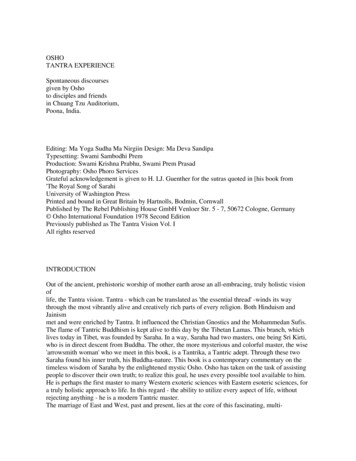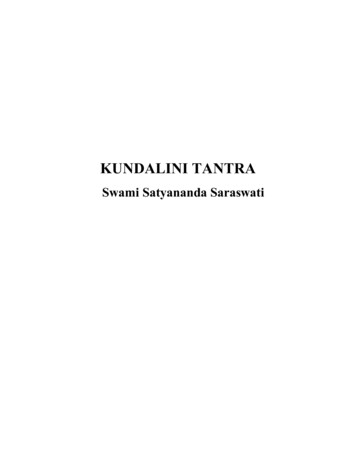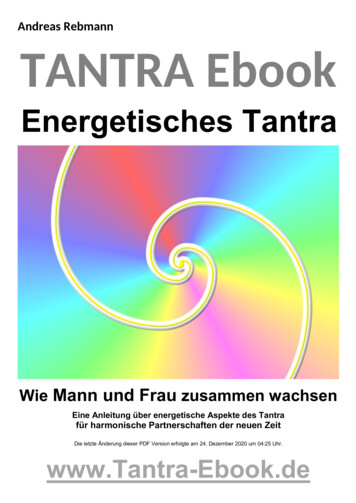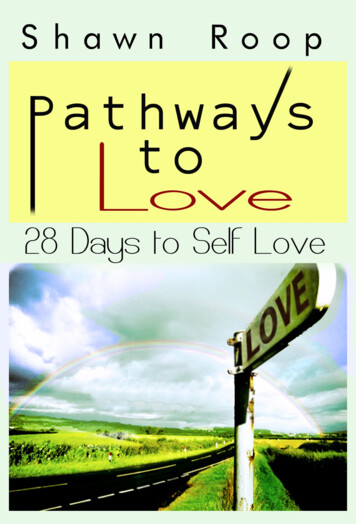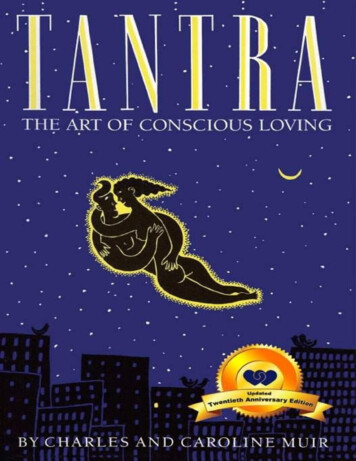
Transcription
Updated Twentieth Anniversary EditionCopyright 1989 and 2010 by Source School of Tantra, Inc.Original Jacket Design: Sharon SmithIllustrations: Debbie DrechslerOriginal Jacket Type and Mechanicals: Madeleine BudnickOriginal Photo of Authors: J. Michael KanouffPublished in the United States bySource Tantra PublicationsPO Box 368, Kahului, Hawaii 96733Phone: 888-6-TANTRA (888-682-6872)Email: school@sourcetantra.comWebsite: www.sourcetantra.comOriginally published in the United States byMercury House, San Francisco, CaliforniaAll rights reserved, including, without limitation, the right of the publisher to sell directly to end usersof this and other Source Tantra Publications. No part of this book may be reproduced in any form orby any electronic or mechanical means, including information storage and retrieval systems, withoutpermission in writing from the publisher, except by a reviewer who may quote brief passages in areview.Source School of Tantra Yoga is a registered trademark of Source School of Tantra, Inc.Manufactured in the United States of America
This book is dedicated to the Spirit of the MotherPREFACEDear Ones,Here we are.twenty years after this book was first published and eight years since our “relationshipsabbatical” that eventually led us down separate paths.where we have each flourished.We know that our years of Tantra practice have allowed us to unwind the parts of our relationshipthat needed to change and keep the ones that still work. “Happily even after” is something we still livetoday. We teach together several times a year, phone and visit each other every week, in a relationshipthat our current partners love and respect. Our bodies energetically remember the years of deepTantric connection, our hugs and cuddles are filled with love forever, and teaching together is a joy toshare.This book has been published in nine languages and read by over a million readers. Since itspublication, we have produced two Hollywood movies, Bliss and The Best Ever, an exquisitelybeautiful DVD, Secrets of Female Sexual Ecstasy, and a series of White Tantra and Red Tantra CDs.Our work has been featured in over fifty media articles, numerous television and radio appearances,and over a hundred books on Tantra, sexuality, Yoga, and relationship. Tantra teachers worldwide useour original experiential Tantra exercises and Source Tantra Sacred Spot Massage Techniques asessential parts of their teaching.A recent Internet search found over a million results for sacred spot massage, and for Tantra, thirtymillion. Our Certified Tantra Educators , whom we have trained, bring this work across North andSouth America, Europe, Asia, and Africa. The modern day Tantra movement that Charles started in1980 has grown beyond our wildest expectations.Sexual Love is an art form, ancient in origin and now needed in the world more than ever before. Ifyou walk this Tantric path of More Love, Consciousness, and Harmony, you will find it.This easy-to-read book is still as relevant and transformative in nature as it was twenty years ago.Sex is a biological urge that every animal species knows. Tantric sexual love is a learned skill that iseasy to master – if you practice it.We send you our blessings and remind you to never be afraid to bring God/Goddess into thebedroom with you. Climax is derived from an ancient Greek word which means “staircase to theheavens”. Enjoy your journey into More Love and Spiritual Awakening. We hope to see you down theTantric path.Aloha,Charles and Caroline MuirTM
CONTENTSPREFACEACKNOWLEDGMENTSINTRODUCTIONPART ITANTRA FOR COUPLESONE HAPPILY EVER AFTERA look at love in our times, the promises that personal independence and growth offer, thedisappointment when the honeymoon is over. What happens to passion? What do men want fromwomen? What do women want from men? Are their differences resolvable?TWO THE TANTRIC WAYAn examination of Tantra’s age-old system of loving; the science of the “subtle body”; thesexual/spiritual connection; the importance of focusing the mind, of becoming a consciouspractitioner.THREE TANTRIC HARMONYThe role of harmony in partnership; balancing yin and yang; the nurturing meditation; breathingtechniques to restore balance; the couple as a team.FOUR TANTRIC COMMUNICATIONLearning the conscious language of love; the master archer; three steps to restoring harmony; gifts oflove.FIVE TANTRIC HEALINGSex in the Age of Darkness; overcoming sexual preconceptions; healing psycho-sexual wounds;partners as healers.PART IISEXUAL PLEASURE: ACHIEVING THE ECSTATIC IN LOVESIX AWAKENING THE GODDESSThe sleeping Goddess; dawn of a New Age; discovering the pleasure poles and awakening the sacredspot; releasing the nectar of the Goddess.
SEVEN PRESERVING THE YANG ELEMENTHow to enjoy orgasm without ejaculating; the secret of extended lovemaking; benefits of ejaculatorycontrol; exercises for developing control.EIGHT THE DANCE OF LOVEA joyful combination of kisses and touches and 1001 movements.NINE SEXUAL SECRETSSecrets of the oral arts; strengthening the love muscle; ways to achieve more powerful orgasms; othersecrets of tantric lovemaking.TEN EXOTIC SEXUAL TECHNIQUESA menu of exotic practices for achieving physical delight.REMEMBRANCES: PUTTING IT INTO PRACTICEBIBLIOGRAPHY
ACKNOWLEDGMENTSThe authors acknowledge the following people for their help in making this book: J. Michael Kanouff,Doris Ober, Alev Lytle Croutier and the team at Mercury House, Marbie Ingalls, Anurag, and Sapan,Charlyn Jordan for the update edit, and Kathy Moon for her help in financing this new updated edition.Caroline expresses her deep and everlasting gratitude for the men and women who have shared withher the ways of Love: Sonny, Rick, Ron, Gina, Tucker, Ronnie, Singh Kaur, and especially her belovedgrandfather, Nank. She adds special thanks “for the union with my greatest love, Charles, who is myteacher and friend for the rest of this life.”Charles sends thanks and blessings to all the teachers on his path who have taught him about Love,especially Bobbi, Michaeline, Mary, Jeannie, Abigail, Jwala, Emily, Diane, Sherry, Jill, Diana,Mercury, Alana, Whitestar, Yaz, and Singh Kaur. He adds, “Special thanks, love, and adoration toPauline Siggia Muir, who has taught me since birth about love, dedication, and service; my son andguru, Orion; the Tara; and especially my beloved Caroline, who is the fruit and seed of my path.”Special credit and thanks to our many students who over the years have helped us learn more aboutourselves, more about others, and more about the art of conscious loving.
INTRODUCTIONThe word Tantra refers specifically to a series of esoteric Hindu books that describe certain sexualrituals, disciplines, and meditations. These ancient Indian books, over two thousand years old, werewritten in the form of a dialogue between the Hindu god Shiva, who is “the penetrating power offocused energy,” and his consort, Shakti, who represents the female creative force and is sometimescalled “the Power of Tantra.” Ancient Tantra is a spiritual system in which sexual love is a sacrament.We are not teachers of ancient tantric traditions and rituals, but we have developed a system based ontantric philosophical concepts and techniques that we have found applicable in our life and in the livesof our students. It is a system that can elevate a couple’s relationship to the level of art. We refer to itas the Art of Conscious Loving.Unfortunately, and contrary to what we would like to believe, we are not born naturally good at sexor at relationships. Few of us have benefited from a formal education in sexuality or sexual love. Eventhough we are children of the sexual revolution, we are still largely conditioned by belief systems thatmay have instilled in us guilt or fear or insecurity or shame. Such negative imprints, although theymay reside quietly in the subconscious and cause only minor or occasional disturbances, rarely allowus to journey into the spiritual potential of sexual love. Tantra can help us do just that because aspiritual goal is as important to the tantric couple as their love.Tantra is a school of many courses in which there are many levels of study and an unlimited degreeof potential for spiritual gain, for sexual delight, and for worldly success. In our workshops andseminars we use techniques that we have developed from some of the ancient tantric lessons. Thesetechniques are designed for the uninitiated, for the beginner. We share them with love and with deeprespect for the potential for pleasure, for healing, and for spiritual growth they can provide.It is one of the tenets of tantric philosophy that the discipline—the tantric lessons—is reborn age toage. We hope you will share our excitement over how extraordinarily well suited to our modern ageand culture these ancient eastern lessons are. They are important tools for today’s couples who aresearching for a significantly different way of relating to each other, couples who want to sustain loveand sexual passion for a lifetime together. We have seen men and women leave our seminars andworkshops in a heightened state of awareness of themselves and of their love, and we have beengratified to learn from the many cards and letters we receive that this heightened awareness betweenthem was not just an anomaly, not just a fleeting occurrence, but has become a permanent part of theirrelationship. Tantric sex does not promise instant results; it is not a “one-minute” technique forachieving sexual prowess. But for couples who want to enrich their relationship, it can release aparticular kind of energy that can bring about harmony between them and increase their sexualpleasure and intimacy. In sum, tantric sex can create an extraordinary partnership.We’ve arranged this book in two parts. The first is an initiation into Tantra, its goals, its philosophyof life, and the science on which its practice is based—how it works, in other words, and specificallyhow it works for the couple. The second part addresses sexual rituals, the yoga or “union” couplespractice to achieve an ecstatic connection in loving.Charles and Caroline MuirKahului, Hawaii
PART ITANTRA FOR COUPLES
ONEHAPPILY EVER AFTERThe wedding was celebrated in great splendor, and they lived happily to the end of their days.“BRIAR ROSE,” in The CompleteFairy Tales of the Brothers GrimmThese days, not many of us believe in happily ever after. Statistics show that well over half themarried couples in our culture divorce, and many of those who stick it out do so for reasons other thanpersonal happiness—because it’s such a hassle dividing everything, moving, having to start over—notto mention children and the emotional and financial aspects of splitting up. In this practical twentiethcentury climate, it’s hard to take happily ever after as much more than a metaphor in which “everafter” means “for a while.”Theoretically, this definition could allow a person to live happily ever after if he or she lived inconsecutively happy-for-a-while relationships. These were fashionable to a degree in the sixties andseventies, but became first questionable and then dangerous in the eighties as the AIDS epidemic wasrecognized and understood. But it is not just fear of AIDS that is changing contemporary relationships.In our seminars we meet men and women whose desire for partnership stems from a feeling that thereis something important to be gained from a significant relationship. And it seems to be more than adesire to “settle down.” Couples today are looking for a commitment from each other, but a specialkind of commitment—one that contains a spiritual as well as a physical element and emotional andpsychological aspects as well as material ones.This is a fairly new phenomenon, and in this regard we may indeed have entered a New Age. Forone thing, the concept of “marrying for love” is relatively new, popular only in the past 150 years orso. Before that, material and political considerations took precedence over any kind of attraction,emotional, physical, or intellectual, and most matches were arranged among families. Consider alsohow the social-sexual aspects of relationships have evolved over the past hundred years in our westernculture, beginning with a period of Victorian values and attitudes that loosened its laces at the turn ofthe last century but didn’t toss away its stays until the 1920s and 1930s. In the forties, warromanticized relationships at the same time that it tore them apart, and the fifties inherited the resultsof that war; people entered the era of the atom bomb with a determination to make the nuclear familywork. Then came the sexual revolution of the sixties, which spawned the women’s movement of theseventies and its demand for social and sexual equality. And so into the eighties, the post-sexualrevolution era, a time of personal movement and personal freedom that the media dubbed the “me”generation. Now, as we approach the turning of another century, men and women seem to want to facelife together. This may be the start of the “we” generation, a generation that desires an end to thebattle of the sexes and the beginning of a new form of relationship in which partners work together asa team to satisfy needs, uplift one another, and journey together toward personal growth and sexualand spiritual fulfillment.PROMISESThe past few decades made us some promises of sexual sophistication, personal independence, and
prosperity. For a large number of men and women today, many of these promises have been fulfilled.We enter into relationships richer than any previous generation. We are richer in knowing more aboutthe world because the media communicate information to us daily, and travel is within the means andpersonal experience of most of us. We are richer because we know more about ourselves—in fact, weare a culture fascinated with itself. We draw elaborate astrological charts and attempt to read thefuture in the star
as the Art of Conscious Loving. Unfortunately, and contrary to what we would like to believe, we are not born naturally good at sex or at relationships. Few of us have benefited from a formal education in sexuality or sexual love. Even though we are children of the sexual revolution, we are still largely conditioned by belief systems that may have instilled in us guilt or fear or insecurity or .

